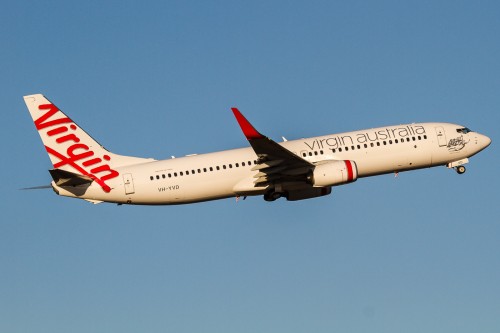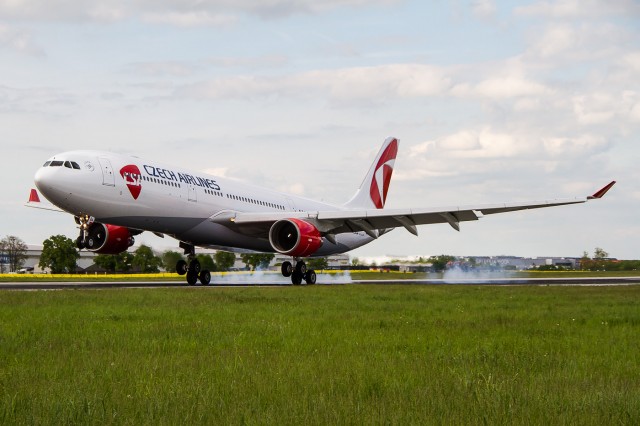
Virgin Australia’s new livery showcasing their transition to a premium-focused carrier Photo: Jacob Pfleger | AirlineReporter
VIRGIN AUSTRALIA BUSINESS CLASS REVIEW BASICS:
Airline: Virgin Australia
Aircraft: Boeing 737-800 (VH-YIF)
Departed: Brisbane Airport (BNE)
Arrived: Sydney Kingsford Smith Airport (SYD)
Stops: Non-stop flight
Class: Business class
Seat: 1F
Length: About 1.5 hours
Cheers: Fresh and funky looking cabin interior and great catering for such a short flight
Jeers: No foot-rests and no curtain divider thus limiting privacy
Overall: A great new business product on the Australian domestic market which with a few improvements will give competitors a run for their money.
During the last two years, perhaps no other airline has gone through as much transformation as Virgin Australia. Starting off as the first true low-cost carrier (LCC) in Australia in 2000 (then known as Virgin Blue) it quickly became a popular choice for leisure travelers. As the Australian market became more saturated with LCCs, Virgin decided it was time to remodel and focus more instead on the premium market. This transformation included the introduction of a business class across the fleet, with all aircraft having completed the re-fit by the 3rd quarter of 2013.

The one and only Czech Airlines A330 – Photo: Jacob Pfleger | AirlineReporter
In May of last year Czech Airlines (CSA) took delivery of their first (leased) Airbus A330-300 aircraft from Korean Airlines. The sole purpose of this aircraft delivery was for Czech Airlines to re-enter the long-haul market on the Prague-Seoul route. Recently, I was fortunate enough to be booked on this aircraft from Prague to Seoul in Business Class and wanted to share my flight experience.
CZECH AIRLINES PRE-DEPARTURE
Being a non-schengen flight, the departure was from Terminal 1 at Prague Airport. I arrived about three hours early; it was interesting to see that Czech Airlines had dedicated check-in for the Seoul flight, with two dedicated business counters. My bag was priority-tagged and I was on my way to passport control within five minutes of arriving at the airport. The security check takes place at the gate for all flights originating from Terminal 1.
After clearing immigration, I made my way to the lounge. The lounge itself was quite modern and well planned out, with numerous phone/device charging stations. It would be nice to see the addition of some hot meals/refreshments, as only cold sandwiches and salads were offered.
Boarding commenced 30 minutes prior to departure. The load today was completely full in economy (majority of travellers were Korean tourists returning home) and only 3/18 in business class. There were two jetways available for boarding.

The empty Business Class cabin on my flight to Seoul. Photo – Jacob Pfleger.
ONBOARD THE CZECH A330-300
Once onboard the aircraft, I was greeted by the purser and escorted to my seat. As the aircraft is an ex-Korean Air bird, the interior and layout is identical to their A330-300’s; the only difference with this one being the paint scheme on the outside is that of Czech Airlines.

Attention to detail with the premium meals is important
The airline business is a complicated machine, where when one little aspect has a minor hiccup, it can affect thousands of people. What better way to see how complicated an airline is than to take a behind-the-scenes look at their catering operation? Recently, during a trip to Istanbul, Turkey, I was invited by Turkish Airlines to tour their catering arm, which is called Do & Co.
Some of the things I found were quite wonderful and surprising.

This Boeing 777-200ER (reg number: (9M-MRO) is suspected to be the one flown on Malaysia Airlines’ flight MH370 | Photo: Thomas Becker
Originally posted March 7, 2014 4:40pm PST. Last updated March 8 3:00pm PST.
Malaysia Airlines flight 370, a Boeing 777-200ER (airplane reg: 9M-MRO) has most likely crashed 153 miles off of Vietnam’s Tho Chu island. The flight was carrying a total number of 239 passengers and crew ’“ comprising 227 passengers (including 2 infants) and 12 crew members. The passengers were of 13 different nationalities.
The location information comes from the Vietnamese Navy, using radar telemetry that is most likely accurate. Also, a 12-mile oil slick discovered in the area also points to the idea that the Boeing 777-200ER was lost here.
’œAn AN26 aircraft of the Vietnam Navy has discovered an oil slick about 20 kilometers in the search area, which is suspected of being a crashed Boeing aircraft,’ Lai Xuan Thanh, the director of the Civil Aviation Administration of Vietnam said. ’œWe have announced that information to Singapore and Malaysia and we continue the search.’

Flight path of flight 370. Image: FlightRadar24.com
The flight, operating Kuala Lumpur (airport code: KUL) to Beijing (airport code: PEK), disappeared and “lost contact” with the airline. The plane lost contact approximately forty minutes in to the usually six-hour flight. Originally reports stated that the aircraft went missing two hours after departure, but the Malaysian defense ministry confirms this not to be true.
Malaysa Airlines has confirmed that the captain of flight 370 started with the airline in 1981 and has logged 18,365 flying hours, while the first officer joined in 2007 and has 2,763 hours logged.
At this point, it will likely be a while until there is official confirmation that the aircraft did crash into the water, and much longer after to determine what exactly happened.
The United States Navy has also joined the search, sending the USS Pickney (a destroyer) and a P-3C Orion in to the area to assist.
The airline has requested that people around the world pray for the passengers of MH370. “Malaysia Airlines humbly asks all Malaysians and people around the world to pray for flight MH370,” they stated in a press release.
This story will be updated…

A6-EYI cruising high above the Australian Outback Photo: Jacob Pfleger | AirlineReporter
Following my experience flying Etihad first class it was time for me to give their economy product a go. Etihad Airways (airline code: EY) had by far the cheapest available ticket from Brisbane to Singapore by about $250, and given my prior experiences with them in their premium cabin it was the perfect choice for me.
As I was traveling in economy, I decided to arrive at the airport three hours prior to departure to be able to get a better seat then the one I selected at the time of booking. The counters were practically deserted, and I was served without delay. I was able to secure a bulkhead seat (15A) at the front of the economy cabin. With the added bonus of having the aisle seat blocked next to me, this was shaping up to be a very good flight, even in economy.






